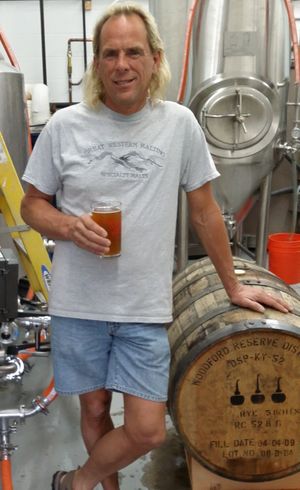7 Sips With … Terry Hackler, Twelve String
This is one in an occasional series of 7 Sips interviews, where we sit down for a pint and seven questions with someone active in the local craft beer community. Today we catch up with Terry Hackler, a longtime guitarist and homebrewer who opened Twelve String Brewing in the Spokane Valley in December 2011.
Q: It seems like there’s never a dull moment at Twelve String. What’s on the front burner these days that you can tell us about?
A: We’re growing like crazy. For 2015, our production will easily be more than double than in 2014. This year we’ll be at 1,300 or 1,400 barrels, which is about our capacity. Whenever we have an empty tank, we brew into it. We’re brewing four days a week, sometimes we brew five days a week, depending on the fermenter schedule.
We’re continuing to search for a (larger) new location. We have a couple of things that we’re looking at very seriously, that I can’t really expand on at this point, that have really good potential. One location in particular that we’re really, really serious about, we’ll know the outcome of that in about two weeks or so. We’ll be in the Valley, hopefully we’ll be within a mile or two of where we are now. We think that will keep our core customers coming, and hopefully gain a lot.
We’re expanding the barrel-aging in big ways. We’ve got somewhere around 48 or 50 barrels full right now. And we have more barrels coming – we’re developing relationships with lots of barrel brokers around, so we have a source for Cruzan rum barrels now, direct from Jamaica. And from another source, I think we’re going to get some gin barrels. We’ve got whiskey barrels, two different kinds of bourbon barrels, rum barrels, tequila barrels, cognac barrels, wine barrels. So that’s turning into a bigger and bigger thing.
And we’re working on bottling. We added another fermenter, which was supposed to pick up some of the slack and allow us to brew enough beer for bottling, but wholesale keg sales have been so huge lately that now we’re not quite sure where we’re going to get the beer to bottle. What we’ll more than likely do initially is do some smaller runs, and have it available for sale in the taproom and maybe a very few select places around town.
Q: What have been your favorite combinations of beers and barrels so far?
A: My favorites are the dark beers we’ve aged in whiskey barrels and bourbon barrels. I like that combination the best, although way back when we aged our Spring Reverb (pale) in a four times used Dry Fly barrel, and that one was delicious. The tequila barrel-aged stuff is weird, you either love it or you hate it. The tequila Mango Mambo, at the Washington Brewers Festival coming up, we’ll go through four or five half-barrels of that by the five-ounce pour – it’s ridiculous. People line up 200 feet for that beer. It’s good, it’s not necessarily my favorite one, but it’s fun. … That (festival) will be the debut of the rum barrel-aged imperial coconut porter. I’m really happy with where that’s gone.
Q: You’re a musician, as the name of the brewery indicates. Do you think that has affected you as a brewer?
A: In the broader scheme of things, most of the stuff I’ve done in my life – I used to be a contractor, I built furniture, I built cabinetry, I’ve written music, and on and on and on – I think that I’m a fairly creative person, and I think all of that kind of parlays into the brewing side of it. I wake up in the middle of the night, like the tequila mango beer, that was a middle of the night thing where it was like, oh, I wonder if I could do this, I wonder where you get tequila barrels, and within five minutes I had that whole plan formulated. Way back when when I was trying to write songs I always kept a notepad by the side of the bed. I don’t keep it by my bed, but I have a whole notebook full of ideas and thoughts and different name ideas and different styles of beer and different recipe ideas, and sometimes I’ll go look at that when I’m thinking of a beer. … People ask me all the time, you have a little test brewery, right? What size are your test batches? And I go, seven barrels. I have a reasonable amount of confidence that my ideas and my recipe formulation skills will at least create something drinkable. I haven’t had to dump one yet.
Q: What’s the first craft beer that you remember trying?
A: Oh, that’s easy. We were going to a concert one night in Seattle at a place called the Backstage in Ballard. I didn’t drink beer, because I didn’t like beer – I could maybe drink a Killian’s Red or something like that because it wasn’t Budweiser, and on a really hot day I could drink a Coors Light, but beyond that I rarely drank beer. But that day was one of those hot days where you just needed a beer. We stood outside forever in the sun, and when we finally got in and sat down, the server came and I said, what beer do you have on tap? She rattled off all the usual suspects, and then she said, we have something called Ballard Bitter, it’s made by a brewery here in town. The brewery in town then was Rainier, and it occasionally put out different beers, remember Rainier Ale? I thought, oh, what the heck, it’s all going to taste the same anyway, so I ordered it. I took one sip and I went, oh, my goodness, that’s delicious, that can’t be Rainier beer. So I asked the gal and she said, oh, that’s made by a brewery over in Fremont in the old trolley building called Redhook. That was when Redhook was brand new (in 1983), they’d only been open a couple of months. The next day, I was back down there by chance, and I cruised around looking for the place, walked in and got a tour from Paul Shipman, one of the founders. I was just fascinated by the process, and I asked him how I could get involved in that, and he sent me up to 145th and Greenwood to The Cellar homebrew store, which was one of the very first homebrew stores in the country. So within three days, I had discovered craft beer, toured a brewery, met Paul Shipman, bought my first homebrew kit and brewed my first batch of beer.
Q: If you could be drinking any beer right now, other than one of your own, what would it be?
A: Barley Brown’s IPA, hands down. Their Pallet Jack IPA is far and away the best beer I’ve ever had in my life. You’ve tried our Batch 201? That was inspired by Pallet Jack.
Q: What’s the biggest thing you’ve learned in your three-plus years of operation?
A: Initially we were surprised how hard it was to sell our beer to outside accounts, bars and restaurants, because there was no awareness of craft beer. Every time a new brewery opened up I thought, oh, no, competition, they’re going to cut into our market. But what I’ve learned instead is that every new good brewery out there that gets on tap someplace creates more awareness for us. When John Bryant came along at No-Li with the whole name change, it created so much awareness of local beer, and I credit him a huge amount with how quickly craft beer in Spokane has grown.
Q: What’s the most important thing that can happen to move local beer forward?
A: Everybody has to make better beer than they’re making. I don’t care how good you think your beer is, you need to figure out how to make it better. At the last couple of Craft Brewers Conferences, they’ve really harped on quality. I really took that to heart at the one last year in Denver and came back and just made wholesale changes – not that our beer was bad, but it made me realize that I could easily step up my game and make it way better. A lot of these new breweries really need to pay attention to that. As the budding beer drinking community in Spokane starts to get more sophisticated, starts drinking better and better beer – now we have Black Raven (being distributed) in town, which is also one of my favorite breweries – my advice to any new brewer who wants to start a brewery is, go out and drink a lot of different beers from a lot of different breweries in a lot of different styles, and ask yourself if anything you make is as good as any of those. And if it isn’t then you need to learn more, you need to do more work, you need to come up with recipes, whatever it is before you try to sell it in the retail market. It’s brutal, people will tell you right to your face, this is the worst damn beer I’ve ever had. There’s people in here that don’t like our beer, and I appreciate that. It makes me sad that they don’t like it but at the same time it makes me go, OK, I need to figure out how to make it even better.

